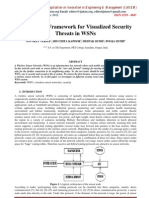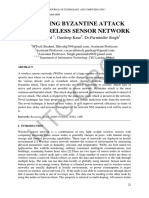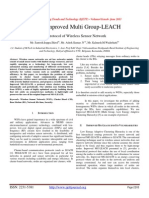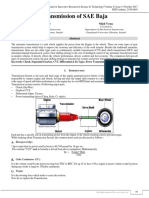Review On Hello Flood Attack in Wireless Sensor Networks
Review On Hello Flood Attack in Wireless Sensor Networks
Uploaded by
IJIRSTCopyright:
Available Formats
Review On Hello Flood Attack in Wireless Sensor Networks
Review On Hello Flood Attack in Wireless Sensor Networks
Uploaded by
IJIRSTOriginal Title
Copyright
Available Formats
Share this document
Did you find this document useful?
Is this content inappropriate?
Copyright:
Available Formats
Review On Hello Flood Attack in Wireless Sensor Networks
Review On Hello Flood Attack in Wireless Sensor Networks
Uploaded by
IJIRSTCopyright:
Available Formats
IJIRST International Journal for Innovative Research in Science & Technology| Volume 3 | Issue 02 | July 2016
ISSN (online): 2349-6010
Review on Hello Flood Attack in Wireless Sensor
Networks
Priyanka
Department of Computer Science & Engineering
GZS Campus College of Engineering & Technology Bathinda,
Punjab, India
Dinesh Kumar
Department of Computer Science & Engineering
GZS Campus College of Engineering & Technology Bathinda,
Punjab, India
Abstract
Wireless sensor networks have emerged a wide application for monitoring physical environment. Energy efficiency, Processing
capability and communication range are the limitations of sensor networks. Moreover, the wireless networks are vulnerable to
certain types of network attacks. One of them is the hello flood attack, in which a non- legal node in the network can flood hello
requests to the legitimate nodes and break the security of WSN. The solutions for these types of attacks are mainly cryptographic
that suffers from heavy computational complexity. Hence, they are less suitable for wireless sensor networks. In this paper, a
new centralized intrusion detection system is proposed to detect and prevent hello flood attacks in cluster-based wireless sensors
networks. The main idea of using centralized detection scheme, in which the base station decides on potential intrusions based on
the control packets that are being sent from the cluster heads. The proposed energy efficient and simple intrusion detection
technique is thus suitable for sensor nodes with resource constrained. Moreso, the simulation result confirms the expected
performance of the proposed intrusion detection system in the terms of security and energy efficiency.
Keywords: Wireless Sensor Network, Centralized Intrusion Detection System _ Misuse Detection
_______________________________________________________________________________________________________
I.
INTRODUCTION
Wireless Sensor Networks (WSNS)
A wireless sensor network is an infrastructure consists of sensing, computing, and communication elements that gives the ability
to instrument to an administrator, observe, and react to events and phenomena in a specified environment. WSN is a large array
of diverse sensor nodes that are interconnected by a communication network. For a distributed estimated system, the sensing data
are shared between the sensor nodes and are used as input. Reliability, Accuracy, Flexibility, Cost effectiveness, and Ease of
deployment are the fundamental objectives for WSN. WSN is made up of individual multifunctional sensor nodes.
Features of Wireless Sensor Networks
Wireless sensor networks have various unique features that are listed below:
Self-organizing
Cooperation of sensor nodes
Dynamically changing topology
Short range communication and multihop routing
Limited energy, computational power and memory
Applications of Wireless Sensor Networks
Military: monitor friendly forces, equipment; battlefield surveillance; reconnaissance of opposing forces; targeting; nuclear,
detection of biological and chemical attack.
Environmental: forest-fire detection; bio complexity-mapping of the environment; flood detection and the precision
agriculture.
Health: tele monitoring of humans physiological data; monitoring as well as tracking doctors and patients inside a hospital;
drug Administration in hospitals.
Home: the home automation; smart environment.
Other commercial areas: environmental control in office buildings; interactive museums; detecting and monitoring the car
thefts; vehicle tracking and detection.
II. CLUSTERING IN WSN
Clustering is a useful mechanism in large multi-hop wireless sensor networks to obtain scalability, low energy consumption and
better network performance. Most of the research has been focused on energy-efficient solutions, but has not thoroughly
All rights reserved by www.ijirst.org
133
Review on Hello Flood Attack in Wireless Sensor Networks
(IJIRST/ Volume 3 / Issue 02/ 025)
analyzed the performance of network, e.g. in terms of data collection rate and time. It is evident that by organizing the sensor
nodes in groups i.e., nodes in the form of clusters, we can achieve significant network performance gains. Clustering not only
allows for aggregation, but also limits the transmission of data primarily within the cluster, thereby reducing both the network
traffic and the contention for the channel.
Grouping sensor nodes into clusters has been widely pursued by the research community in order to achieve the network
scalability objective. To support data aggregation through efficient network organization, nodes can be partitioned into a number
of small groups called clusters, where each cluster has a coordinator, referred to as a cluster head, and a no. of member nodes.
Clustering results in a two-tier hierarchy in which cluster heads (CHs) forms higher tier while member nodes form the lower tier.
The member nodes report about their data to the respective CHs. The CHs aggregate the data and send to the central base
through other CHs as CHs often transmit data over longer distances and they lose more energy as compared to member nodes.
The network may be periodically reclustered in order to select the energy abundant nodes to serve as CHs, thus distributing the
load uniformly to all the nodes. Besides achieving energy efficiency, clustering reduces the channel contention and collisions of
packet, resulting in better network throughput under high load.
A CH can schedule the activities in cluster so that the nodes can switch most of the time to the low-power sleep mode and
reduces the rate of energy consumption. Sensors can be engaged in a round-robin order and the time for their transmission and
reception can be determined so to avoid sensors reties, redundancy can be limited and medium access collision is prevented.
Moreso, a CH can aggregate the whole data collected by the sensors in its cluster and thus decrease the no. of relayed packets.
III. HELLO FLOOD ATTACK
Many of the protocols which use HELLO packets make the naive assumption that receiving such a packet means that the sender
is within radio range and is therefore a neighbor. An adversary may use a high-powered transmitter to track a large area of nodes
believing that they are neighbors of that transmitting node. If the adversary broadcasts falsely a superior route to the base station,
all of these nodes will attempt the transmission to the attacking node, despite many being out of radio range in reality.
Fig. 1: HELLO flood attack in WSN
IV. CONCLUSION
In WSNs, two of the most important concerns are the requirement of low power consumption and the vulnerability to many types
of security threats. In order to address the above points, we have proposed in this paper an intrusion detection system(IDS)
dedicated to cluster-based wireless sensor networks(WSNs). In fact, our IDS can detect routing attacks such as black hole
attacks. Our IDS uses a simple intrusion detection technique and is energy efficient, it is thus suitable for sensor nodes with
resource constrained .Here the detection of Hello Flood Attacks is done and the protocols which use HELLO packets make the
assumption that receiving such a packet means sender is within radio range and is therefore a neighbor.
REFERENCES
[1]
[2]
[3]
[4]
[5]
A.Stetsko; L. Folkman; V. Matyas , Neighbor-Based Intrusion Detection for Wireless Sensor Networks FIMU-RS-2010-04,May 2010.
C.S Dutta; Utpal Biswas, Intrusion Detection System for Power-Aware OLSR , Jan. 12, 2015 to Jan. 13, 2015, ISBN: 978-1-4799-7548-8, pp: 142147,2015.
Faouzi Hidoussi, Homero Toral-Cruz, Djallel Eddine Boubiche, Kamaljit Lakhtaria, Albena Mihovska, Miroslav Voznak, Centralized IDS Based on
Misuse Detection for Cluster-Based Wireless Sensors Networks,Vol.85, No.1,2015.
Yi-Ying Zhang; Wen-Cheng Yanng; Kee- Bum Kim; Min-Yu Cui; Myong-Soon Park, A Rekey-Boosted Security Protocol in Hierarchical Wireless
Sensor Network International Conference on Multimedia and Ubiquitous Engineering, MUE-2008.
S.Magotra, K. Kumar, Detection of HELLO flood attack on LEACH protocol, IEEE 2014.
All rights reserved by www.ijirst.org
134
Review on Hello Flood Attack in Wireless Sensor Networks
(IJIRST/ Volume 3 / Issue 02/ 025)
[6]
[7]
[8]
[9]
[10]
[11]
[12]
[13]
Haiguang Chen; Huafeng Wu; Xi Zhou; Chuanshan Gao, Key Feature and Rule-based Intrusion Detection for Wireless Sensor Networks, Network and
Parallel computing workshops,2007.
Saleem, M. S. Khalil, N. Fisal, A. A. Ahmed , Efficient Random Key Based Encryption System for Data Packet Confidentiality in WSNs ,IEEE
International Conference on Trust, Security and Privacy in Computing and Communications, 2013.
A.S.K Pathan, Security in wireless sensor networks: issues and challenges, ICACT-2006.
Kun Zhang , A Secure Routing Protocol for Cluster-Based Wireless Sensor Networks Using Group Key Management, IEEE March 2014.
Virendra Pal Singh; Sweta Jain; Jyoti Singhai, Hello Flood Attack and its Countermeasures in Wireless Sensor Networks, IJCSI, May 2010.
X. Zhenghong, C. Zhigang , A Secure Routing Protocol with Intrusion Detection for Clustering Wireless Sensor Networks, IEEE 2010.
B. Kannhavong, A survey of routing attacks in mobile ad hoc networks , IEEE October 2007.
Tanveer A Zia; Md Zahidul Islam, Communal Reputation and Individual Trust (CRIT) in Wireless Sensor Networks, IEEE Feb 2010.
All rights reserved by www.ijirst.org
135
You might also like
- Analysis of Security Protocols in Wireless Sensor Network: Ritu Sharma Yogesh ChabaDocument7 pagesAnalysis of Security Protocols in Wireless Sensor Network: Ritu Sharma Yogesh ChabaHiran VNNo ratings yet
- 6512 Thesis ModifiedDocument68 pages6512 Thesis ModifiedRaja KishoreNo ratings yet
- A Proposed Framework For Visualized Security Threats in WsnsDocument6 pagesA Proposed Framework For Visualized Security Threats in WsnsInternational Journal of Application or Innovation in Engineering & ManagementNo ratings yet
- Virtual Energy Based Encryption & Keying On Wireless Sensor NetworkDocument10 pagesVirtual Energy Based Encryption & Keying On Wireless Sensor NetworkInternational Organization of Scientific Research (IOSR)No ratings yet
- (IJCST-V4I4P10) :er. Amandeep Kaur, Dr. Sandeep Singh KangDocument9 pages(IJCST-V4I4P10) :er. Amandeep Kaur, Dr. Sandeep Singh KangEighthSenseGroupNo ratings yet
- Investigation and Exclusion of Attackers in WSN Using Secure Multipath Routing ProtocolDocument9 pagesInvestigation and Exclusion of Attackers in WSN Using Secure Multipath Routing ProtocolKARTHIKNo ratings yet
- International Journal of Engineering Research and Development (IJERD)Document8 pagesInternational Journal of Engineering Research and Development (IJERD)IJERDNo ratings yet
- A Survey On Secure Clustering Protocols 2018Document11 pagesA Survey On Secure Clustering Protocols 2018hhakim32No ratings yet
- A Review On Anomaly Detection Techniques For Wireless Sensor NetworksDocument6 pagesA Review On Anomaly Detection Techniques For Wireless Sensor NetworksInternational Journal of Application or Innovation in Engineering & ManagementNo ratings yet
- Pca-Based Distributed Approach For Intrusion Detection in WsnsDocument20 pagesPca-Based Distributed Approach For Intrusion Detection in WsnsMicah MorrisNo ratings yet
- A New Hybrid Cryptography Technique in Wireless Sensor NetworkDocument20 pagesA New Hybrid Cryptography Technique in Wireless Sensor NetworkajithNo ratings yet
- Introduction To Wireless Sensor NetworksDocument13 pagesIntroduction To Wireless Sensor NetworksJuan Sanchez Alarcon100% (1)
- Reliable Energy Efficient Clustering Scheme Analysis Using Mobile Sink in Wireless Sensor NetworksDocument6 pagesReliable Energy Efficient Clustering Scheme Analysis Using Mobile Sink in Wireless Sensor NetworksseventhsensegroupNo ratings yet
- IJETR032192Document4 pagesIJETR032192erpublicationNo ratings yet
- Two-Way Authentication Algorithm For Sinkhole Attack Isolation in WSNDocument5 pagesTwo-Way Authentication Algorithm For Sinkhole Attack Isolation in WSNInternational Journal of Innovative Science and Research Technology100% (1)
- Wireless Sensor Network-Unit-2Document3 pagesWireless Sensor Network-Unit-2Aravapalli SrinubabuNo ratings yet
- LEDS - An Innovative Corridor of Data Security in WSNDocument5 pagesLEDS - An Innovative Corridor of Data Security in WSNEditor IJRITCCNo ratings yet
- 50120140505014Document9 pages50120140505014IAEME PublicationNo ratings yet
- SangeethaDocument34 pagesSangeethaseethacse.meNo ratings yet
- 1.1 Overview of Wireless NetworksDocument41 pages1.1 Overview of Wireless NetworkspriyaNo ratings yet
- Designing Architecture For Security of Wireless Sensor Networks EnvironmentalDocument8 pagesDesigning Architecture For Security of Wireless Sensor Networks EnvironmentalJournal of TelecommunicationsNo ratings yet
- Ijret20150414004 PDFDocument4 pagesIjret20150414004 PDFManoj VarmaNo ratings yet
- Data-Centric Routing Protocols in Wireless Sensor Networks: A SurveyDocument6 pagesData-Centric Routing Protocols in Wireless Sensor Networks: A SurveyAnuskaNo ratings yet
- IJTC201603001-Detecting Byzantine Attack Using Wireless Sensor NetworkDocument8 pagesIJTC201603001-Detecting Byzantine Attack Using Wireless Sensor NetworkInternational Journal of Technology and Computing (IJTC)No ratings yet
- SecureRoutingThroughTrustedNodesin IJARCET VOL 3 ISSUE 11 3792 3799Document9 pagesSecureRoutingThroughTrustedNodesin IJARCET VOL 3 ISSUE 11 3792 3799Mullai Kodi KNo ratings yet
- A Survey On Security Attacks in Wireless Sensor Network: Rajkumar Sunitha K R Dr.H.G.ChandrakanthDocument8 pagesA Survey On Security Attacks in Wireless Sensor Network: Rajkumar Sunitha K R Dr.H.G.ChandrakanthVikas PsNo ratings yet
- Bio-Inspired Ant Colony Optimization Based Clustering Algorithm With Mobile Sink For Home Automation and Cyber SecurityDocument9 pagesBio-Inspired Ant Colony Optimization Based Clustering Algorithm With Mobile Sink For Home Automation and Cyber SecurityIJRASETPublicationsNo ratings yet
- WSN ch12345Document156 pagesWSN ch12345sanyalmohona18No ratings yet
- Hierarchical Intrusion Detection System in Cluster Based Wireless Sensor Network Using Multiple Mobile Base StationsDocument6 pagesHierarchical Intrusion Detection System in Cluster Based Wireless Sensor Network Using Multiple Mobile Base StationsIAEME PublicationNo ratings yet
- Security and Key Management Challenges Over WSN (A Survey)Document20 pagesSecurity and Key Management Challenges Over WSN (A Survey)ijcsesNo ratings yet
- Security in WSNDocument26 pagesSecurity in WSNTanvir OnifNo ratings yet
- Ijettcs 2013 06 22 115Document5 pagesIjettcs 2013 06 22 115International Journal of Application or Innovation in Engineering & ManagementNo ratings yet
- Seminar ReportDocument26 pagesSeminar Reportharishk03No ratings yet
- Lightweight Intrusion Detection For WireDocument21 pagesLightweight Intrusion Detection For WireIsmail MainboyNo ratings yet
- Ijesat 2012 02 01 14Document7 pagesIjesat 2012 02 01 14Anil ChowdaryNo ratings yet
- Analysis of Wireless Sensor NetworksDocument5 pagesAnalysis of Wireless Sensor NetworksesatjournalsNo ratings yet
- Robust and Energy Efficient Wireless Sensor Networks Routing AlgorithmsDocument73 pagesRobust and Energy Efficient Wireless Sensor Networks Routing Algorithms- -0% (1)
- Unit 2Document43 pagesUnit 2Tilottama DeoreNo ratings yet
- Unit Ii: Sensor Networks - Introduction & ArchitecturesDocument8 pagesUnit Ii: Sensor Networks - Introduction & Architecturesece.kavitha mamcetNo ratings yet
- Lecture - 1 Introduction and Overview of Wireless Sensor NetDocument25 pagesLecture - 1 Introduction and Overview of Wireless Sensor Netbigb19944No ratings yet
- A Self-Adaptive Sleep Wake-Up SchedulingDocument82 pagesA Self-Adaptive Sleep Wake-Up SchedulingAsha SumithaNo ratings yet
- Secure Improved Multi Group-LEACHDocument5 pagesSecure Improved Multi Group-LEACHseventhsensegroupNo ratings yet
- تحديات ال wsns PDFDocument5 pagesتحديات ال wsns PDFfree5050No ratings yet
- Project Report On Super Nodes - An Embedded ApproachDocument24 pagesProject Report On Super Nodes - An Embedded ApproachKarthikNo ratings yet
- WSN Unit 1Document22 pagesWSN Unit 1Gaurav bansodeNo ratings yet
- Discover and Prevent The Sinkhole Attacks in Wireless Sensor Network Using Clustering ProtocolDocument3 pagesDiscover and Prevent The Sinkhole Attacks in Wireless Sensor Network Using Clustering ProtocolChinna Swamy100% (1)
- Emerging trends in scienceDocument10 pagesEmerging trends in sciencep.maheswariopenventioNo ratings yet
- Project ProposalDocument13 pagesProject Proposalmarineluka2016No ratings yet
- A Highly Accurate Deep Learning Based Approach For Developing Wireless Sensor Network MiddlewareDocument14 pagesA Highly Accurate Deep Learning Based Approach For Developing Wireless Sensor Network Middlewaresumi kannaNo ratings yet
- Compusoft, 3 (4), 746-751 PDFDocument6 pagesCompusoft, 3 (4), 746-751 PDFIjact EditorNo ratings yet
- Security PDFDocument23 pagesSecurity PDFMd. HishamNo ratings yet
- A Review: Wireless Sensor Networks and Its Application, Platforms, Standards and ToolsDocument7 pagesA Review: Wireless Sensor Networks and Its Application, Platforms, Standards and ToolsseventhsensegroupNo ratings yet
- ReportDocument26 pagesReportDeepak_Gilkarw_7497No ratings yet
- Ijvspa 1Document14 pagesIjvspa 1Praduman SinghNo ratings yet
- Implementing A Cooperative Mac Protocol For Wireless LansDocument8 pagesImplementing A Cooperative Mac Protocol For Wireless LansJournal of Computer ApplicationsNo ratings yet
- The Gateway The Wireless Network and Aggregate Data From Distributed WSN and Help To Achieve A Desired ResultDocument5 pagesThe Gateway The Wireless Network and Aggregate Data From Distributed WSN and Help To Achieve A Desired ResultshikhaNo ratings yet
- Computational Intelligence in Wireless Sensor Networks A SurveyDocument29 pagesComputational Intelligence in Wireless Sensor Networks A SurveyCmpt CmptNo ratings yet
- Chapter 2Document18 pagesChapter 2Arthur TrevorNo ratings yet
- Handbook of Ultra-Wideband Short-Range Sensing: Theory, Sensors, ApplicationsFrom EverandHandbook of Ultra-Wideband Short-Range Sensing: Theory, Sensors, ApplicationsNo ratings yet
- Radio Resource Management in Multi-Tier Cellular Wireless NetworksFrom EverandRadio Resource Management in Multi-Tier Cellular Wireless NetworksNo ratings yet
- Development of Satellite Data For Infrastructure Updation and Land Use/Land Cover Mapping - A Case Study From Kashipur & Chhatna Block, Bankura & Purulia District, West BengalDocument7 pagesDevelopment of Satellite Data For Infrastructure Updation and Land Use/Land Cover Mapping - A Case Study From Kashipur & Chhatna Block, Bankura & Purulia District, West BengalIJIRSTNo ratings yet
- Patterns of Crop Concentration, Crop Diversification and Crop Combination in Thiruchirappalli District, Tamil NaduDocument10 pagesPatterns of Crop Concentration, Crop Diversification and Crop Combination in Thiruchirappalli District, Tamil NaduIJIRSTNo ratings yet
- Currency Recognition Blind Walking StickDocument3 pagesCurrency Recognition Blind Walking StickIJIRSTNo ratings yet
- Satellite Dish Positioning SystemDocument5 pagesSatellite Dish Positioning SystemIJIRST100% (1)
- Arduino-UNO Based Magnetic Field Strength MeasurementDocument4 pagesArduino-UNO Based Magnetic Field Strength MeasurementIJIRSTNo ratings yet
- Development of Tourism Near Loktak Lake (Moirang) in Manipur Using Geographical Information and Management TechniquesDocument4 pagesDevelopment of Tourism Near Loktak Lake (Moirang) in Manipur Using Geographical Information and Management TechniquesIJIRSTNo ratings yet
- Social Impact of Chukha Hydro Power On Its Local Population in BhutanDocument2 pagesSocial Impact of Chukha Hydro Power On Its Local Population in BhutanIJIRSTNo ratings yet
- Transmission of SAE BajaDocument5 pagesTransmission of SAE BajaIJIRST100% (1)
- Automated Online Voting System (AOVS)Document4 pagesAutomated Online Voting System (AOVS)IJIRSTNo ratings yet
- Literature Review For Designing of Portable CNC MachineDocument3 pagesLiterature Review For Designing of Portable CNC MachineIJIRSTNo ratings yet
- Analysis of Fraudulent in Graph Database For Identification and PreventionDocument8 pagesAnalysis of Fraudulent in Graph Database For Identification and PreventionIJIRSTNo ratings yet
- Analysis and Design of Shear Wall For An Earthquake Resistant Building Using ETABSDocument7 pagesAnalysis and Design of Shear Wall For An Earthquake Resistant Building Using ETABSIJIRSTNo ratings yet
- Modeled Sensor Database For Internet of ThingsDocument4 pagesModeled Sensor Database For Internet of ThingsIJIRSTNo ratings yet
- Welcome To Powerschool Support For Schoology Learning: June 2022Document16 pagesWelcome To Powerschool Support For Schoology Learning: June 2022arifhafiziNo ratings yet
- Phase 3 - Design Integration StrategiesDocument16 pagesPhase 3 - Design Integration Strategiesdeelite31100% (2)
- Conceptual DependencyDocument5 pagesConceptual DependencyPattisapu Manikanta ManoharNo ratings yet
- Flexible Instruction Delivery Plan (Fidp)Document2 pagesFlexible Instruction Delivery Plan (Fidp)Neil Patrick John AlosNo ratings yet
- Facebook ComplaintDocument123 pagesFacebook ComplaintTechCrunchNo ratings yet
- Lingu 02Document80 pagesLingu 02John ArthurNo ratings yet
- Broad Topic: Language Issues in Jamaica. Narrow Topic: The Extent To Which Patois Is Valued and RecognizedDocument3 pagesBroad Topic: Language Issues in Jamaica. Narrow Topic: The Extent To Which Patois Is Valued and RecognizedKay DouglasNo ratings yet
- Issues in Transcribing Spoken Discourse Part1Document36 pagesIssues in Transcribing Spoken Discourse Part1terpsidNo ratings yet
- Module 2 Lesson 1 Module 2 Lesson 1 ActivityDocument2 pagesModule 2 Lesson 1 Module 2 Lesson 1 Activitymae DamaNo ratings yet
- Apply For Ethiopian Passport Online25Document1 pageApply For Ethiopian Passport Online25Abreham AynalemNo ratings yet
- Daily Lesson Plan For Year 5 KBSR ScienceDocument4 pagesDaily Lesson Plan For Year 5 KBSR Scienceester_zack076675No ratings yet
- Communication Management in Project Teams PDFDocument8 pagesCommunication Management in Project Teams PDFdaohoaflowerNo ratings yet
- BUCIO - BH - Assignment 1Document2 pagesBUCIO - BH - Assignment 1John McwayneNo ratings yet
- Asja Wright Resume 2020 PDFDocument1 pageAsja Wright Resume 2020 PDFapi-509993021No ratings yet
- Curriculum Vitae: Sunny Sunil Jagtap Mb. 7499952503Document2 pagesCurriculum Vitae: Sunny Sunil Jagtap Mb. 7499952503SunnyNo ratings yet
- Mishra Panini PaperDocument6 pagesMishra Panini PaperMnvMadhvaNo ratings yet
- Rachel Williams Cover Letter Classroom TeacherDocument1 pageRachel Williams Cover Letter Classroom Teacherapi-248733360No ratings yet
- Corpus Linguistics at Work - Language TeachingDocument33 pagesCorpus Linguistics at Work - Language TeachingChoi Philip100% (1)
- MusicvideoDocument7 pagesMusicvideoapi-208041294No ratings yet
- EL106 - Chapter 1 PDFDocument7 pagesEL106 - Chapter 1 PDFElmer Pajarito BelarminoNo ratings yet
- SLAC Plan SY 2019-2020Document6 pagesSLAC Plan SY 2019-2020grace nacman100% (1)
- R2 SignallingDocument55 pagesR2 SignallingSuman GhimireNo ratings yet
- Understanding The Relation Content Branding and Its Impact On ScaleDocument10 pagesUnderstanding The Relation Content Branding and Its Impact On ScaleSheikh IrfanNo ratings yet
- Oral Comm ReviewerDocument3 pagesOral Comm ReviewerXhejian EwanNo ratings yet
- Edma360 - Assignment TwoDocument3 pagesEdma360 - Assignment Twoapi-358330682No ratings yet
- The Concept of Modern Technology in Educational Science and PracticeDocument1 pageThe Concept of Modern Technology in Educational Science and PracticeNuraneNo ratings yet
- ALİ Masangila-Writing Quiz2 Adv T3 1 AMDocument2 pagesALİ Masangila-Writing Quiz2 Adv T3 1 AMMasangila AliNo ratings yet
- Lesson Plan - MagnetDocument5 pagesLesson Plan - Magnetapi-380946388No ratings yet
- Nair 2009Document10 pagesNair 2009alihatemalsultaniNo ratings yet
- Brand Management ReviewerDocument4 pagesBrand Management ReviewerGABRIEL MICHAEL UMALINo ratings yet






































































































